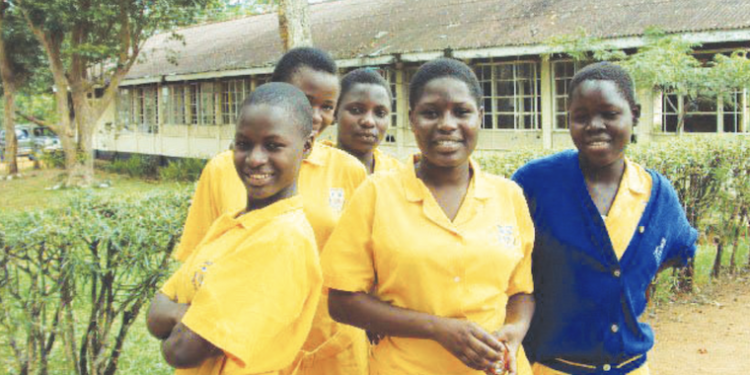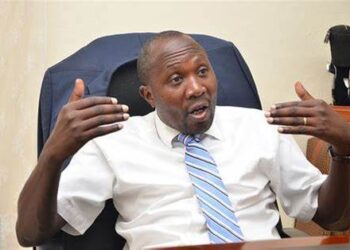By THE OBSERVER UG
The recent social media uproar about the fee structures of major schools in Uganda sheds light on the escalating cost of education.
In urban districts like Kampala, Wakiso, and Mukono, school fees vary from Shs 1.4 million to Shs 3.3 million, while in districts like Jinja and Mityana, fees range between Shs 500,000 and Shs 1 million. These figures underscore a significant financial burden for parents, especially those with multiple children.
For instance, a parent with three children could spend nearly Shs 10 million per term, excluding additional costs like shopping, school trips, and student upkeep. This expenditure can easily exceed Shs 12 million per term. A specific case mentions a parent paying approximately Shs 14 million each term for five children, totaling a staggering Shs 42 million annually.
To meet such expenses, a parent would need a substantial income, at least Shs 8 million per month, to comfortably save around Shs 4.5 million monthly for school fees alone.
Contrasting these figures with the average income levels in Uganda, where most citizens earn no more than Shs 3 million per month, it becomes evident that a significant portion of the population faces financial strain in affording quality education for their children. This situation has led many parents to juggle school fee balances and loans, raising the question of whether education in Uganda is increasingly becoming a privilege reserved for the wealthy class.
A parent who declined to be named to speak freely said he takes out a loan of about Shs 10 million from his community Sacco every term to pay fees. The affordability of education, therefore, emerges as a critical issue, reflecting the broader socio-economic challenges in the country and the increasing disparity between income levels and the cost of quality education.
Return on Investment and Job Market Realities
Analyzing the value of education in Uganda becomes particularly pertinent when considering the substantial financial investment in schooling against the prospective earnings in the current job market. By the time a child completes their education, parents may have invested hundreds of millions of shillings. However, this substantial educational expenditure often does not correlate with the starting salaries in the job market, especially when considering the differing prospects for arts and science graduates.
For individuals with an arts background, entry-level positions typically offer salaries ranging between Shs 400,000 and Shs 700,000. In contrast, graduates with a science degree tend to have slightly higher starting salaries, ranging from Shs 600,000 to Shs 1 million.
This disparity raises critical questions about the return on investment in education. Parents and students are confronted with the reality that the high cost of education does not necessarily guarantee commensurately high starting salaries. Consequently, this scenario demands a closer examination of the education system’s effectiveness in preparing students for the workforce and the alignment of educational costs with the economic realities of the job market.
Government Intervention and Regulatory Challenges
Last week, Joseph Ssewungu raised concerns in parliament about the escalating school fees in Uganda, highlighting a pressing issue that has been discussed multiple times but remains unresolved. He drew attention to the exorbitant fees being charged, particularly for nursery education, stating, “As we talk now, parents are being charged Shs 3 million for a nursery kid, and the government is watching.”
Ssewungu’s comments underscore the financial burden parents are facing, urging the government to address what seems to be excessive charging by schools.
This issue is not new to parliament. Previously, Opio Samuel Acuti had brought up the matter, advocating for the establishment of a standardized fee structure across Ugandan schools. He criticized the current system’s lack of uniformity, which allows schools to define various items as part of school fees, leading to parent exploitation.
Acuti highlighted the disparity in fee components across different schools: “When you look at the report that has been presented, the definition of school fees is defined by each school. When you look at Kisubi, it has 29 items defined as school fees. Kibuli has 15 items defined as school fees. Nabisunsa has six items defined as school fees. What are school fees?”
He proposed a uniform fee system, akin to that of universities, where fees are clearly defined and standardized across all institutions, both private and public.
In response, the Ministry of Education and Sports announced plans to regulate school fees. State Minister Peter Ogwang declared that schools would require written authorization from the ministry’s permanent secretary to increase fees. However, the effectiveness of this directive remains uncertain.
Both public and private schools continue to set their fees independently, adding financial strain to many families. Despite the government’s implementation of Universal Primary Education (UPE) and Universal Secondary Education (USE) programs to provide free education, some public schools are still charging fees, further complicating the education affordability landscape in Uganda.
Last week, Dr Denis Mugimba, the spokesperson for the Ministry of Education and Sports, appeared on television to address the issue of development fees in Ugandan public schools. He clarified that the government, not parents, is responsible for funding the development of its schools.
“The government allocates funds for development through the school facilities grant, and such schools [that charge development fees from parents] do it illegally,” Dr Mugimba stated. He highlighted that over the past three years, KCCA schools have received an annual grant of Shs. 1.5 billion.
Dr Mugimba differentiated between two categories of public schools: those entirely owned and funded by the government, and those not fully owned by the government but receiving grant aid for school materials and teacher salaries. This distinction sheds light on why some public schools still charge fees from parents.
Additionally, Martin Kizito, a parent, expressed concerns about the state of government schools under the Universal Primary Education (UPE) and Universal Secondary Education (USE) programs. Despite these initiatives aimed at providing free education, he observed that many such schools are poorly facilitated and in a deteriorating condition.
“Most government schools lack learning materials and teachers don’t have morale due to poor payments, which leaves us no choice but to take our children to facilitated private schools which overcharge us,” Kizito said. He urged the government to increase funding to these schools to make them more conducive for learners.
Kizito’s assertion underscores a systemic issue in Uganda’s education sector. While the government has made efforts to provide free education through UPE and USE, the inadequacy in facilities and teacher remuneration in many public schools forces parents to opt for private education, despite the higher costs.
This situation not only questions the effectiveness of the government’s education initiatives but also highlights the need for increased investment in public schools to ensure equitable access to quality education. The disparity in school funding and its implications on education quality and affordability reveal a gap that needs addressing to ensure the right to education for all Ugandan children.
Fee Cap Proposal and Regulatory Challenges
Increasingly, tuition fee hikes have become commonplace at the commencement of every school term, despite repeated government warnings against any unauthorized school fee increases. Surprisingly, the majority of schools disregard these warnings because no stringent disciplinary measures are enforced. Proprietors of errant schools face no consequences like license or registration certificate cancellations.
Last year, the Ministry of Education proposed the imposition of a fee cap for schools. This decision came in response to what the ministry referred to as a “national outcry on school fees” and the establishment of a committee in 2016 to investigate concerns about fees in various educational
institutions. The committee, chaired by Prof Frederick Ian Kayanja, formulated recommendations, which regrettably remained unimplemented.
A source with insight into the committee’s workings revealed that the suggested fees structure was never put into practice by the ministry, primarily due to its perceived impracticality.
“The report didn’t go far, though the minister [of Education and Sports] Janet Museveni held a series of meetings to dissect its findings. When such regulations are enacted, the most difficult challenge is always implementation. There are times when, as technocrats, you look at something and conclude that you can’t go far with it…” the source said.
Top education ministry officials invoked the statutory instrument from Section 7 of the 2008 Education Act, which grants the ministry the authority to regulate fees within the sector. At the time, the ministry was endeavoring to establish a policy framework for private schools but was grappling with lack of a legal foundation.
The new draft statutory instrument, as reviewed by The Observer, introduces regulations and penalties for transgressors. For instance, school owners who impose fees exceeding the prescribed cap would commit an offense and could face a penalty upon conviction, not exceeding fifty currency points (equivalent to Shs 1 million), a prison term not exceeding 12 months, or both.
The proposed fee cap for all schools, excluding government grant-aided institutions, is as follows: pre-primary – Shs 690,000; primary – Shs 570,000 (day) and Shs 1,220,000 (boarding); secondary and vocational institutions – Shs 960,000 (day) and Shs 1,610,000 (boarding). It’s important to note that the education ministry did not attempt to regulate international schools that charge fees as high as Shs 25 million per semester.
Below are some of the major schools and their fee structures for the year 2024.
|
School
|
Fees Structure
|
|
Wakiso district
|
|
|
Kings College Buddo
|
2,553,000
|
|
Uganda Martyrs Namugongo
|
3,155,000
|
|
Gayaza High School
|
2,600,000
|
|
Trinity college Nabingo
|
2,800,000
|
|
St Mary’s Kitende
|
3,300,000
|
|
Mugwanya Summit College Kyengera
|
1,060,000
|
|
Buddo SS
|
1,900,000
|
|
St Mark’s College Namagoma
|
1,500,000
|
|
Merryland high secondary school Entebbe
|
1400000
|
|
Greenlight Islamic School Nansana
|
1,295,000
|
|
|
|
|
Kampala district
|
|
|
Nabisunsa Girls SS
|
3,000,000
|
|
Kawempe Muslim SS
|
2,680,000
|
|
Makerere College School
|
2,504,000
|
|
Namirembe Hillside High School, Gayaza
|
2,500,000
|
|
St Peters Nsambya SS
|
1,500,000
|
|
St Lucia Hill School Namagoma
|
1,550,000
|
|
|
|
|
Mukono district
|
|
|
St Joseph SS Naggalama
|
2,350,000
|
|
Mt St Mary’s Namagunga
|
2,480,000
|
|
Seeta High School
|
2,500,000
|
|
St Lawrence SS Sonde Namugongo
|
1,683,000
|
|
|
|
|
Iganga district
|
|
|
Iganga SS
|
1,800,000
|
|
Bukoyo SS
|
700,000
|
|
|
|
|
Mbarara district
|
|
|
Ntare School
|
2,020,000
|
|
|
|
|
Masaka district
|
|
|
St Henry’s College Kitovu
|
2,170,000
|
|
Masaka Secondary School
|
1,243,000
|
|
|
|
|
Luwero district
|
|
|
Katikamu SDA secondary schoo
|
l 1,950,000
|
|
|
|
|
Jinja district
|
|
|
Jinja SS
|
570,000
|
|
|
|
|
Lira district
|
|
|
Lango College, Lira City
|
600,000
|
|
|
|
|
Butambala district
|
|
|
Gombe SSS
|
2,100,000
|
|
|
|
|
Mityana district
|
|
|
Pride SS Mityana
|
650,000
|
|
|
|
|
Kaliro district
|
|
|
Kaliro High
|
450,000
|







Discussion about this post